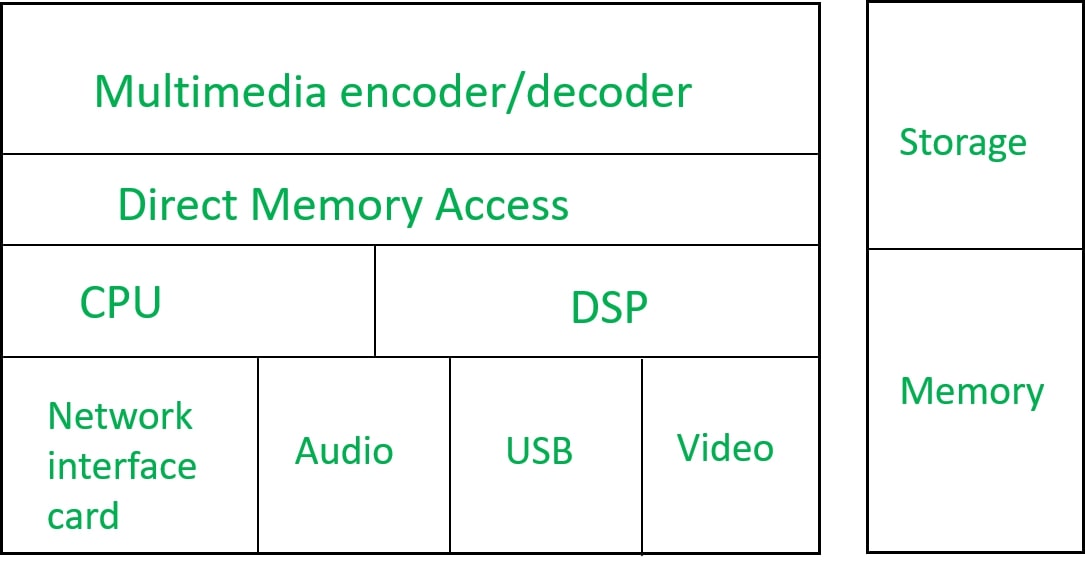SoC stands for System On Chip. It is a small integrated chip that contains all the required components and circuits of a particular system. The components of SoC include CPU, GPU, Memory, I/O devices, etc. SoC is used in various devices such as smartphones, Internet of Things appliances, tablets, and embedded system applications. In this article, we are going to see the architecture and architectural features of SoC.
Architecture of SoC
The following diagram shows us the architecture of SoC:

The basic architecture of SoC is shown in the above figure which includes a processor, DSP, memory, network interface card, CPU, multimedia encoder/decoder, DMA, etc.
Processor: It is the heart of SoC, usually SoC contains at least one or more than one coprocessor. It can be a microcontroller, microprocessor, or DSP. Most of the time DSP is used in every SoC as a processor.
DSP: DSP stands for Digital Signal Processor. It is included in SoC to perform signal processing operations such as data collection, data processing, etc. it is also used for the purpose of decoding the images.
Memory: Memory is used in SoC for the purpose of storage. It may be a volatile or non-volatile memory. Volatile memory includes RAM there are two types of RAM one is SRAM and another is DRAM. The non-volatile memory includes ROM.
Encoder/Decoder: Used for the purpose of interrupting information and converting it into codes.
Network Interface card: SoC has an internal interface or bus or network to connect all individual blocks. Basically, the Network interface card provides a connection of the network to the system.
GPU: GPU stands for Graphical Processing Unit, used in SoC to visualize the interface. GPU is specially designed to speed up the operations related to image calculations. The basic blocks of the GPU are the Bus interface, Power Management Unit, Video Processing unit, Graphics Memory Controller, Display interface, etc.
Peripheral devices: Externally connected devices/interfaces such as USB, HDMI, Wi-Fi, and Bluetooth are included in peripheral devices. This device is used in SoC to perform various operations.
UART: Universal Asynchronous Receiver Transmitter is included in SoC which is used to transmit or receive serial data. Voltage regulators, Oscillators, clocks, and ADC/DAC are also part of SoC.
Now let us see some advantages and disadvantages of SoC.
Features of SoC
1. Incorporation of Parts: SoC design coordinates different parts like the central processing unit (CPU), memory subsystems (RAM, ROM), input/yield interfaces (GPIO, UART, USB), illustrations handling units (GPU), gas pedals, and more onto a solitary chip.
2. Conservative Plan: SoC empowers the making of exceptionally reduced and space-proficient figuring gadgets because of the solidification of numerous capabilities onto a solitary chip.
3. Power Productivity: By improving part connections and lessening information development between various chips, SoCs can accomplish better power effectiveness contrasted with customary multi-chip frameworks.
4. Execution Improvement: SoCs can convey upgraded execution by empowering parts to impart all the more proficiently and limiting postponements related with between chip correspondence.
5. Customization and Versatility: SoC models can be modified to meet explicit prerequisites, permitting planners to pick and incorporate just the parts important for a specific application. This customization additionally takes into consideration adaptability across various gadget models.
6. Low Idleness: SoC configuration limits information move distances, bringing about diminished inertness among parts and quicker generally framework responsiveness.
7. Decreased Interconnect Intricacy: Incorporating parts onto a solitary chip improves the interconnect structure and diminishes the intricacy of planning and overseeing correspondence pathways.
8. High level Bundling Procedures: SoC designs frequently use progressed bundling advances like Framework in-Bundle (Taste) and 3D stacking to additional improve joining and execution.
9. Multicore Handling: SoCs can consolidate numerous handling centers, empowering effective equal handling and performing multiple tasks abilities.
10. Heterogeneous Registering: SoCs can join various sorts of handling units, like computer chips, GPUs, DSPs, and specific gas pedals, to enhance execution for different jobs.
Advantages of SoC
- It is small in size and includes many features and functions.
- It consumes low power.
- SoC is flexible in terms of size, and power factor.
- It is built on a single chip.
- It is cost-effective.
- It is produced in a large quantity.
Disadvantages of SoC
- Time-consuming designing process. Usually, a designing process of SoC takes six to twelve months.
- If any component of the SoC is not functioning properly then it cannot be replaced in that case an entire SoC has to be replaced.
- Visibility of SoC is limited.
Uses of SoC
- Used in smartphones, smartwatches, tablets, and computers.
- Internet of Things applications such as home automation.
- Embedded systems applications especially where the microcontroller is used.
Like Article
Suggest improvement
Share your thoughts in the comments
Please Login to comment...